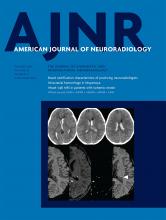Abstract
BACKGROUND AND PURPOSE: The standard for evaluating interval radiologic activity in MS, side-by-side MR imaging comparison, is restricted by its time-consuming nature and limited sensitivity. VisTarsier, a semiautomated software for comparing volumetric FLAIR sequences, has shown better disease-activity detection than conventional comparison in retrospective studies. Our objective was to determine whether implementing this software in day-to-day practice would show similar efficacy.
MATERIALS AND METHODS: VisTarsier created an additional coregistered image series for reporting a color-coded disease-activity change map for every new MS MR imaging brain study that contained volumetric FLAIR sequences. All other MS studies, including those generated during software-maintenance periods, were interpreted with side-by-side comparison only. The number of new lesions reported with software assistance was compared with those observed with traditional assessment in a generalized linear mixed model. Questionnaires were sent to participating radiologists to evaluate the perceived day-to-day impact of the software.
RESULTS: Nine hundred six study pairs from 538 patients during 2 years were included. The semiautomated software was used in 841 study pairs, while the remaining 65 used conventional comparison only. Twenty percent of software-aided studies reported having new lesions versus 9% with standard comparison only. The use of this software was associated with an odds ratio of 4.15 for detection of new or enlarging lesions (P = .040), and 86.9% of respondents from the survey found that the software saved at least 2–5 minutes per scan report.
CONCLUSIONS: VisTarsier can be implemented in real-world clinical settings with good acceptance and preservation of accuracy demonstrated in a retrospective environment.
ABBREVIATIONS:
- AIC
- akaike information criterion
- CSSC
- conventional side-by-side comparison
- EDSS
- Expanded Disability Status Scale
- VT
- VisTarsier
- © 2019 by American Journal of Neuroradiology












